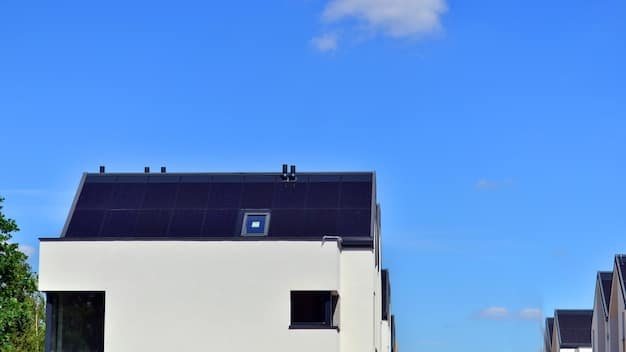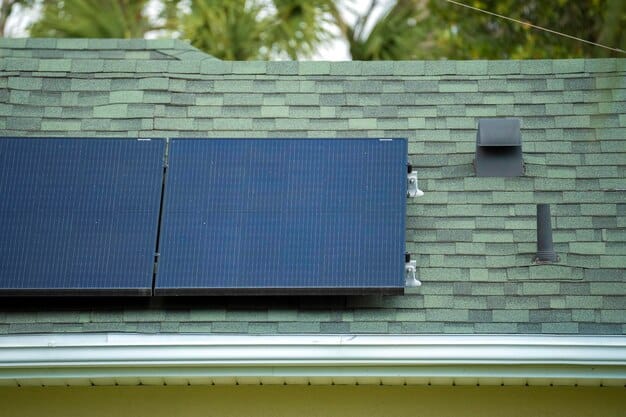Solar Panel Efficiency: Latest Innovations in Home Energy

Solar panel efficiency in residential energy generation is constantly improving, with advancements like perovskite cells, bifacial panels, and smart technologies leading to higher energy yields and cost savings for homeowners.
Harnessing the power of the sun to fuel our homes is becoming increasingly efficient and accessible. Let’s explore the groundbreaking advancements in solar panel efficiency: What’s the latest in residential energy generation? and how these innovations are shaping the future of sustainable energy for homeowners.
Understanding Solar Panel Efficiency
Solar panel efficiency is the measurement of how well a solar panel converts sunlight into electricity. Higher efficiency panels generate more electricity from the same amount of sunlight, making them a crucial factor for maximizing energy production in residential settings.
Several factors influence this efficiency, including the type of solar cell material, the panel’s design, and environmental conditions. As technology advances, understanding the drivers behind these improvements is essential for homeowners considering solar energy.
Key Metrics for Solar Panel Efficiency
The efficiency of a solar panel is typically expressed as a percentage. This percentage represents the ratio of electricity produced by the panel to the amount of sunlight hitting its surface. Other metrics such as temperature coefficient and degradation rate also play significant roles.
A higher temperature coefficient means the panel’s performance is less affected by heat, while a lower degradation rate indicates a slower decline in efficiency over time. These factors contribute to the overall long-term energy output and return on investment.
- Cell Type: Monocrystalline, polycrystalline, and thin-film solar cells have varying efficiencies.
- Panel Design: Bifacial panels can capture sunlight from both sides, boosting efficiency.
- Environmental Factors: Temperature, shading, and angle of sunlight impact performance.
In conclusion, solar panel efficiency is a multifaceted concept involving various technological and environmental factors. By understanding these elements, homeowners can make informed decisions when investing in solar energy systems, optimizing performance and savings.

Advancements in Solar Cell Technology
The heart of any solar panel is the solar cell itself. Over the years, materials and technologies used in these cells have evolved, leading to significant improvements in efficiency and performance. These innovations are crucial for making solar energy more competitive and accessible.
From traditional silicon-based cells to emerging materials like perovskite, the quest for the perfect solar cell continues. Here’s a look at some of the key advancements driving this evolution.
Monocrystalline vs. Polycrystalline Cells
Monocrystalline and polycrystalline cells have been the standard for many years. Monocrystalline cells, made from a single crystal of silicon, are known for their higher efficiency but come at a higher cost. Polycrystalline cells, made from multiple silicon fragments, are more affordable but generally less efficient.
Recent advancements have narrowed the efficiency gap between these two types. Manufacturers are improving polycrystalline cell production techniques to enhance their performance, making them an increasingly attractive option for budget-conscious consumers.
The Rise of Perovskite Solar Cells
Perovskite solar cells represent a groundbreaking advancement in solar technology. These cells, made from organic-inorganic hybrid compounds, have demonstrated remarkable efficiency gains in a relatively short period. Their potential to surpass traditional silicon cells is generating significant excitement in the industry.
Perovskite cells are also thinner and more flexible than silicon cells, opening up new possibilities for applications such as flexible solar panels and transparent solar coatings. However, challenges remain in terms of long-term stability and scalability.
- Efficiency Gains: Perovskite cells have shown rapid improvements in lab settings.
- Cost Reduction: Potential for lower manufacturing costs compared to silicon.
- Versatility: Can be used in flexible and transparent applications.
To summarize, advancements in solar cell technology are revolutionizing the solar energy landscape. By exploring new materials and refining existing technologies, researchers are paving the way for more efficient, affordable, and versatile solar solutions for residential use.
Bifacial Solar Panels: Capturing More Sunlight
Bifacial solar panels are designed to capture sunlight from both the front and back sides, offering an innovative approach to boosting energy production. This dual-sided capability significantly enhances the overall efficiency compared to traditional monofacial panels.
The design and placement of these panels play a crucial role in maximizing their potential. Understanding how they work and where they are most effective can help homeowners make the most of this technology.
How Bifacial Panels Work
Unlike conventional panels that only absorb sunlight from one side, bifacial panels have solar cells on both surfaces. This allows them to capture light reflected off the ground or surrounding surfaces, increasing the total amount of sunlight converted into electricity.
The additional energy generated from the rear side can significantly boost the overall output of the panel. The amount of gain depends on factors such as the reflectivity of the surface beneath the panel and the panel’s mounting height.
Optimizing Placement for Maximum Gain
To maximize the benefits of bifacial panels, careful consideration must be given to their placement. Surfaces with high reflectivity, such as white roofing or light-colored gravel, can significantly enhance the amount of light captured by the rear side.
Additionally, mounting the panels higher off the ground allows for better airflow and less shading, further improving their performance. Proper orientation towards the sun is still crucial, but the added rear-side capture provides a substantial advantage.
- Reflective Surfaces: Increase light capture on the rear side.
- Mounting Height: Higher placement improves airflow and reduces shading.
- Orientation: Proper positioning towards the sun remains essential.
In conclusion, bifacial solar panels represent a significant step forward in solar technology, offering increased energy production and improved efficiency. By understanding how they work and optimizing their placement, homeowners can harness the full potential of this innovative solution.
Smart Solar Technologies for Enhanced Performance
Smart solar technologies are revolutionizing how we manage and optimize solar energy systems. These technologies integrate sensors, data analytics, and automation to improve performance, monitor system health, and enhance overall efficiency.
From smart inverters to energy storage solutions, these innovations are making solar energy more reliable, efficient, and user-friendly. Let’s explore some of the key components of smart solar technologies.

Smart Inverters and Monitoring Systems
Smart inverters are a critical component of modern solar systems. These inverters not only convert DC electricity from the solar panels into AC electricity for the home but also provide real-time data on system performance. They can detect issues, optimize energy output, and communicate with the grid.
Monitoring systems allow homeowners to track energy production, consumption, and savings through user-friendly interfaces. These systems provide valuable insights into system health and performance, enabling proactive maintenance and optimization.
Energy Storage Solutions: Batteries and Beyond
Energy storage solutions, such as batteries, are essential for maximizing the benefits of solar energy. By storing excess energy generated during the day, homeowners can use it during the evening or during periods of low sunlight, reducing their reliance on the grid.
Advanced battery technologies, such as lithium-ion and solid-state batteries, offer improved energy density, longer lifespans, and enhanced safety features. These storage solutions are becoming increasingly affordable and accessible, making them a key element of smart solar systems.
- Real-time Data: Smart inverters provide insights into system performance.
- Self-Consumption: Energy storage allows for greater use of solar energy.
- Grid Independence: Reduces reliance on the utility grid.
As a result, smart solar technologies are transforming the way we harness and manage solar energy. By integrating advanced monitoring systems, smart inverters, and efficient energy storage, homeowners can maximize the benefits of solar power, ensuring reliability, efficiency, and cost savings.
The Impact of Environmental Factors on Efficiency
Environmental factors such as temperature, shading, and weather conditions significantly impact the efficiency of solar panels. Understanding these influences is crucial for optimizing system performance and ensuring long-term reliability.
Mitigating the negative effects of these factors can lead to improved energy production and greater savings. Let’s examine how these elements affect solar panel efficiency and what steps can be taken to address them.
Temperature Effects on Solar Panel Performance
Solar panels are affected by temperature. As temperatures rise, the voltage output of the panels decreases, leading to reduced electricity generation. This phenomenon is described by the temperature coefficient, a key metric for evaluating panel performance.
Choosing panels with a low temperature coefficient can help minimize the impact of heat on efficiency. Additionally, proper ventilation and mounting can help keep panels cooler, improving their overall performance during hot weather.
The Role of Shading and Weather Conditions
Shading from trees, buildings, or other obstructions can significantly reduce the amount of sunlight reaching the panels, decreasing their energy output. Even partial shading can have a disproportionate impact on performance.
Weather conditions such as clouds, rain, and snow also affect solar panel efficiency. While solar panels can still generate electricity on cloudy days, their output is significantly reduced compared to sunny conditions. Regular cleaning to remove dirt and debris can help maintain optimal performance.
- Temperature Coefficient: Choose panels with a low temperature coefficient.
- Shading Analysis: Conduct a shading analysis to minimize obstructions.
- Regular Maintenance: Clean panels regularly to remove dirt and debris.
In conclusion, environmental factors play a vital role in solar panel efficiency. By understanding and mitigating the effects of temperature, shading, and weather conditions, homeowners can optimize the performance of their solar energy systems and maximize their investment.
Future Trends in Residential Solar Energy
The future of residential solar energy is bright, with ongoing research and development promising even more efficient, affordable, and sustainable solutions. Several emerging trends are poised to transform the way we harness solar power in our homes.
From advanced materials to integrated energy management systems, these innovations are set to revolutionize the residential solar energy landscape. Here’s a glimpse into the future of solar power.
Next-Generation Solar Cell Materials
Research into new solar cell materials is paving the way for higher efficiency and lower costs. Materials like perovskites, quantum dots, and organic semiconductors hold great promise for surpassing the performance of traditional silicon cells.
These materials offer the potential for flexible, lightweight, and transparent solar panels, opening up new applications and design possibilities. As these technologies mature, they could significantly reduce the cost of solar energy and make it more accessible to homeowners.
Integrated Energy Management Systems
Integrated energy management systems are becoming increasingly sophisticated, combining solar power generation, energy storage, and smart home technologies. These systems optimize energy use, reduce reliance on the grid, and enhance overall energy efficiency.
With advanced monitoring, control, and automation, homeowners can manage their energy consumption more effectively, reduce costs, and contribute to a more sustainable energy future. These integrated systems are set to become a standard feature of modern homes.
- Advanced Materials: Promising higher efficiency and lower costs.
- Energy Storage: Critical for maximizing self-consumption and grid independence.
- Smart Home Integration: Enhances energy management and overall efficiency.
Therefore, the future of residential solar energy is filled with exciting possibilities. With ongoing advancements in materials, technologies, and integrated systems, solar power is poised to become an even more integral part of our homes, driving a sustainable and affordable energy future.
| Key Point | Brief Description |
|---|---|
| 💡 Efficiency Metrics | Understanding metrics like temperature coefficient is vital for optimal performance. |
| ☀️ Bifacial Panels | Bifacial panels capture sunlight from both sides, boosting energy production. |
| 🔋 Smart Storage | Energy storage solutions maximize self-consumption and grid independence. |
| 🌡️ Environmental Factors | Temperature and shading impact solar panel efficiency, requiring mitigation strategies. |
Frequently Asked Questions (FAQ)
▼
Solar panel efficiency is the measure of how well a solar panel converts sunlight into electricity. It’s important because higher efficiency means more electricity generated from the same amount of sunlight, leading to greater energy production and cost savings for homeowners.
▼
Bifacial solar panels capture sunlight from both the front and back sides, unlike conventional panels that only use one side. This dual-sided capture increases the total amount of sunlight converted into electricity, enhancing overall efficiency and energy output.
▼
Environmental factors like temperature, shading, and weather conditions significantly affect solar panel efficiency. High temperatures can reduce voltage output, shading decreases sunlight capture, and weather conditions like clouds can lower overall energy production.
▼
Smart solar technologies integrate sensors, data analytics, and automation to improve solar energy systems. They include smart inverters that provide real-time data, monitoring systems for tracking performance, and energy storage solutions to maximize self-consumption and reliability.
▼
Future trends include next-generation solar cell materials like perovskites for higher efficiency, integrated energy management systems combining solar power and smart home technologies, and advanced energy storage solutions to reduce grid reliance and enhance energy efficiency.
Conclusion
In summary, the latest advancements in solar panel efficiency are transforming residential energy generation. From innovative solar cell technologies like perovskites and bifacial panels to smart energy management systems, homeowners now have access to more efficient, reliable, and sustainable energy solutions. By understanding these developments, individuals can make informed decisions to harness the full potential of solar power and drive a greener future.





